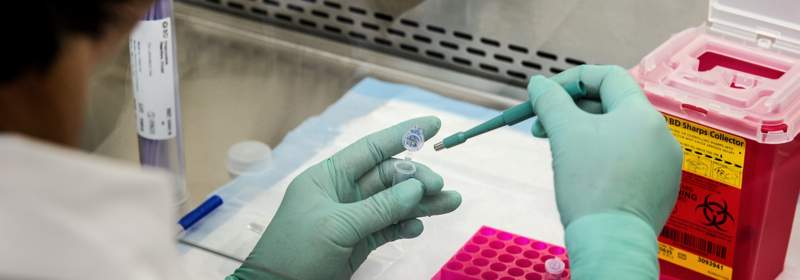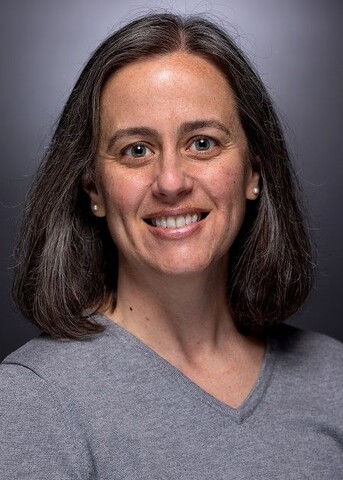1. It’s sneaky.
COVID-19 can spread very quickly and largely unnoticed. People with COVID-19 are highly contagious in the 1-2 days before they even develop any symptoms. They don’t know they are infected, and so may be out and about, visiting with friends and family, and spreading the virus without realizing it. If and when they develop symptoms, those symptoms might be very mild, so again they don’t realize what’s happened and their close contacts don’t even know that they’ve been exposed and potentially infected. This is what allows this virus to spread so quickly through communities. We may not even know it’s there until it has hit the most vulnerable people, who then may get severely ill.
This is different from most other viruses, such as influenza or SARS. With those infections, people are typically most contagious when they feel most ill, at which time they are home in bed (or hospitalized) and so not spreading the virus around much if at all.
Additionally, because it is new, there is practically no pre-existing immunity to this virus; we are pretty much all susceptible to getting it. This also contributes to the virus spreading very rapidly - everyone is a target and potential host.
So, it’s scary that this virus can spread so quickly through a highly vulnerable community. I have never in my professional life seen anything like it (Ebola would be similar, but I have not personally experienced that in my career).
2. It can quickly overwhelm medical and health care facilities.
As we saw in Italy, Spain, and New York City, since this virus can spread so quickly and sneakily, it can rapidly outpace the ability of our health care systems to manage those who need hospitalization or other support. Frantically turning non-ICU hospital floors into ICU wards and recruiting pediatricians, podiatrists, radiologists, and other non-ICU physicians to help take care of ICU patients is not good care, and so patient outcomes are worse, resulting in more suffering and, often, unnecessary deaths. During the height of NYC’s outbreak, the FDNY, which runs the 911 ambulance service and normally receives about 3000 calls per day, was receiving over 7000 ambulance calls per day. Their max capacity is 4000, and so they recruited telehealth physicians from all over the country to help take 911 calls and try to help triage them. Their dead-on-arrival numbers went way up – they just weren’t able to get to people in time. (https://www.nytimes.com/2020/03/28/nyregion/nyc-coronavirus-ems.html)
Hospitals were also overwhelmed and couldn’t take appropriate care of the heart attacks, strokes, and other medical issues that continued to occur. Refrigerated trucks needed to be brought in to store the corpses, as the morgues were overfull. (https://www.forbes.com/sites/lisettevoytko/2020/04/01/overwhelmed-nyc-hospitals-reportedly-implementing-do-not-resuscitate-policies-for-coronavirus-patients/#387488b83146 )
When Houston had a large outbreak, they had to start admitting adult patients to a pediatric hospital – again, not ideal care. (https://www.houstonchronicle.com/news/houston-texas/houston/article/Texas-Children-s-admitting-adult-patients-because-15359004.php)
It is scary that this virus seems to be very able to get quickly out of control and overwhelm our systems. I have never in my adult life seen an infection do this before with the exception of HIV in certain regions of the country when that epidemic first started.
3. We still don’t have enough PPE, testing supplies, or public health infrastructure.
We have been more fortunate in Wisconsin than in other places, but still most health care facilities are having their staff re-wear their N95 respirators (typically designed to be disposed of after each patient) not only all day long, but for a whole week, and then ship them to get decontaminated and reused. This is not ideal and increase the risk of health care workers getting infected. (https://www.medpagetoday.com/special-reports/exclusives/88815?xid=nl_mpt_DHE_2020-09-26)
Additionally, as our state case counts rise, many area laboratories are starting to run low on the swabs and reagents that are needed to do the tests. If cases continue to rise, we won’t have sufficient ability to test everyone who needs it. When we can’t test, we can’t keep tabs on what the virus is doing and where it’s spreading, thus greatly reducing our ability to control it.
Finally, our current system relies on identifying infected people (via a test) to get them into isolation where they can’t spread the virus, then notifying their close contacts (who have been exposed and may be infected) and getting them into quarantine, again so that they can’t accidentally spread it. Making all of these phone calls take a lot of time, and tracking this information take robust systems. We do not have enough contact tracers to deal with the current situation – if it gets worse, we will really lose our ability to try to contain this virus through these public health measures.
This is scary, because when we can’t take measures to protect public and health care worker safety, things can break down quickly.
4. We still don’t know a lot about it, especially long-term effects.
This is a new virus, here for less than a year now. We already know that a high percentage of people will have lingering symptoms for months or longer, oftentimes severe enough to keep them out of work. (https://jamanetwork.com/journals/jama/fullarticle/2771111?utm_source=silverchair&utm_campaign=jama_network&utm_content=covid_weekly_highlights&utm_medium=email)
We also have evidence that, even in mild cases and even in young people, this virus does cause inflammation of the lungs and heart. (Lung scarring: COVID-19 interstitial pneumonia: monitoring the clinical course in survivors) (Heart inflammation: What COVID-19 Does to the Heart) We don’t know yet if that will heal in time or if it will lead to chronic heart and lung problems in those people down the road. It would be terrible if even a small percentage of all the many young people currently getting infected ended up with lifelong medical problems because of this virus. We just don’t know yet.
Other viruses, such as HPV, Hepatitis C, and HIV, have been shown to cause cancer later on – we don’t know yet whether or not that will happen with this virus. We also have no data yet on whether this virus will negatively affect the growing brains, hearts, and lungs of our children.
This is scary to me, as I just don’t know what will happen. Right now, my young adult patients who are getting COVID-19 seem to be doing overall quite well and not getting very sick (as expected). But I don’t know that we’re not setting them up for major health problems down the road. They might be totally fine, but they might not. We just don’t know yet.
5. Even a small percentage can be a lot of people.
As we continue to get better at diagnosing and treating this illness, we get better data on what the mortality rate is. Currently, we think that overall it’s likely between 0.1 and 1% (and if you subdivide into different age groups, can be significantly higher or lower). But because there are so many infections happening, COVID is currently causing about 10% of all deaths in the U.S. (https://www.cdc.gov/nchs/nvss/vsrr/covid_weekly/index.htm) That is a lot of people.
In our county of 45,000 or so people, if everyone got infected (as could happen) a 0.1% mortality rate would mean 45 deaths. Those are friends, neighbors, and family members. If a bus carrying 45 people to Country Fest crashed and all aboard died, that would be a major tragedy. Those 45 deaths would also be a >10% increase in our typical annual county deaths (in 2015, we had 341 deaths total in the county). (https://www.dhs.wisconsin.gov/publications/p4/p45358-2017-dunn.pdf )
Deaths would just be the tip of the iceberg, however. Aside from deaths, there are also hospitalizations. In Wisconsin, 6% of all cases have been severe and required hospitalization. (https://www.dhs.wisconsin.gov/covid-19/cases.htm ) For Dunn County, if everyone got infected, that would be 2700 hospitalizations! In order to achieve herd immunity, it’s hypothesized that 60% or more of a community would need to be immune. If we tried to do that by getting infected, those 27,000 infections would result in 1620 hospitalizations! Our local hospitals (with 30 total beds or fewer) cannot support that, nor could even our regional or nearest metropolitan ones, unless it was spread out over a very long period of time.
Large numbers of those folks would be working adults – teachers, health care workers, police officers, business owners, farmers, and others who we rely upon to run our community and our economy (hospitalization rate for people aged 30-60 in WI is 5%). Those who get ill could also lose out on much needed income during the time of their illness, not to mention medical bills, which would cause significant economic hardship for our community members. Many would also be parents of young children or adult caretakers of elderly parents, who then would struggle to find substitute caregivers for those dependent on them. The social impacts could be vast.
So this is scary not just because it could cause a significant increase in deaths over a very short time, but also because of the large number of moderate to severe illnesses that could result, causing suffering, economic and social hardship, and overburdening of our health system capacity.
In Conclusion
Given that COVID can spread rapidly to a lot of people and cause significant illness in a decent proportion of those folks, causing hardships on our communities in multiple ways, and given that we don’t yet know the long term effects of this virus (and early data suggests there will be some), it makes sense from a medical perspective to try to slow the spread as much as we can to buy some time. That time will allow us to develop safe and effective vaccines as well as improved treatments and to learn more about what the longer-term consequences of infection might be.
It’s absolutely possible that our community could withstand a very major outbreak without a lot of suffering or hardship, but it does not seem likely. Therefore, I support public health mitigation
Memberships
Alexandra Hall M.D. – Dr. Hall earned a Bachelor’s of Science in Science Education from New York University, taught high school in East Harlem, and then earned her M.D. from Mount Sinai School of Medicine.
She then completed a residency in Family Practice and served as Chief Resident at the University of Vermont. After practicing medicine for Dean Health System in Wisconsin and then at Cornell University in Ithaca, NY, Dr. Hall moved to Menomonie, WI to work at UW Stout, where she currently teaches for the Biology department and serves as a physician at Student Health Services.
Dr. Hall has a passion for educating people about health and science; she gives workshops regionally and nationally on various medical topics to both lay and professional audiences and has won several teaching awards for her work.



Add new comment